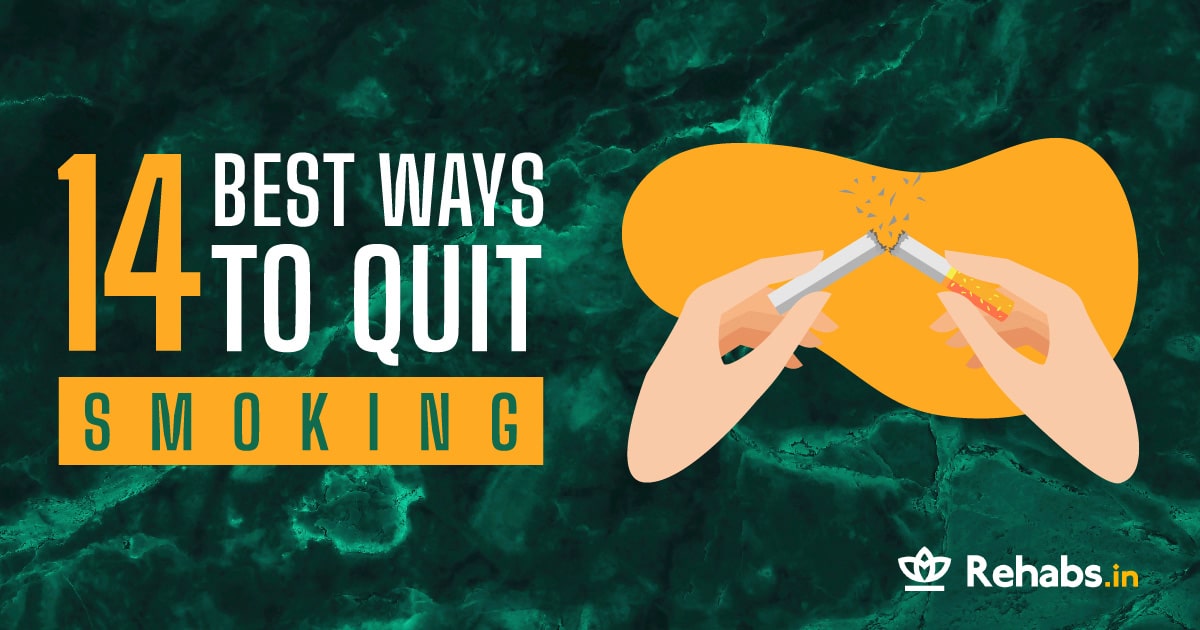14 Best Ways To Quit Smoking

The following blog has been reviewed by a Psychologist. If you are reading the blog on a mobile phone, you can see the reviewer’s profile at the end of the blog. Please see our editorial policy here.
Congratulations on your first step towards quitting smoking!
Smoking is a physical and psychological addiction. Most think overcoming smoking is tough, and it’s true. Nicotine in tobacco is an addictive drug and a potent stimulus. It refrains one from quitting.
Ending smoking doesn’t happen on a single day. It is an expedition that requires a lot of patience, confidence and motivation.
Deciding to leave tobacco is a half win over the battle. Recognising the reasons for craving and planning makes a person smoke-free.
Everything is possible, but it requires a lot of effort and control. Millions of people have stopped smoking forever. With the right tactic, you can kick out smoking for good. While controlling smoking, the withdrawal symptoms caused must be managed in specific ways.
Here are the 14 best ways to quit smoking to cope with the symptoms:
Natural Ways To Quit Smoking
- Delay Smoking
One of the ways to stop your nicotine cravings is to delay smoking every time you get an urge. Try delaying it for five to ten minutes. In those ten minutes, decide to go for a walk or play a mobile game that makes you utilise your thinking skills or keep yourself active with some intellect stimulating activity such as reading that distracts you. It would be enough to derail your cravings.
Some of the common triggers for smoking:
- Stress, depression, anxiety, or even boredom
- In the morning while having a cup of tea or coffee
- After a meal
- While consuming alcohol
- Social circle of smokers
- Cut “Just One”
“Just one cigarette” is the biggest trap. To please the urge, if you light up, then you may not stop there.
For example, while having a coffee or after a meal, you might be tempted to smoke. If you fail to control and start to light up a cigarette – it may lead to lighting up more than one at frequent intervals You won’t stop smoking, and this will not help you out. So, avoid the dirty deal.
Before your quit date, have your final taste of a cigarette. After that, you should not think about it.
- Concentrate on Work
In the long run of quitting, you must keep yourself busy. To eliminate cravings and triggers, you have to focus on work. The more you concentrate, the less you will have the urging effect.
Most might feel disconcerting to quit smoking on weekends. So, enhance the plan to start from Monday, as you could place yourself busy with work or studies. If you smoke a bit high during weekdays because of work pressure, try avoiding it on weekends.
- Look at Reasons
A person who has a clear purpose and plan – reaches the goal. To stay on track with confidence and motivation, introspect the reason why you chose to quit, that will back you up again.
Few reasons for most to quit smoking:
- To remain with excellent health benefits
- Improve appearance
- Save money
- Enrich self-esteem
- Enhance stamina for playing sports
- To protect the family from second-hand smoking
- To look young
Choose a strong motive to leave smoking and write it down. Place it at a noticeable location where you can often take a look to stay motivated. The purpose will help you control the urge and withdrawal symptoms.
- Spend Time With Loved Ones or Non-Smokers
Tell your loved ones about your decision to quit smoking. The encouragement and support they show might get you away from going back to it again. Whenever you provoke cravings, have a conversation with them about how you feel.
If you don’t want your loved ones to know about your smoking condition, then tell it to a non-smoking friend.
Why not smoking friends? Because sometimes, if you’re with them – you might get lured into smoking again. So it is better to share your thoughts about quitting with your non-smoking friend.
Even if you have relapsed, make sure the person doesn’t criticise. Choose a person who can support you and emphasise on you quitting.
- Physical Exercise
The best distractions that cut the intensity of craving is physical activity. Making it a daily practise to go to the gym and work out for 30 minutes at least will help you get over your addiction.
In case you have a lot of work to do, try to formulate an exercise routine at home or office. Try push-ups or climb staircases instead of using the elevator. Even walking and jogging will help you rejuvenate and keep you away from the urge.
- Practice Relaxation
Stress is the apparent reason for smoking. When you scrutinize most people’s nicotine cravings factor, it would be pressure. Even suppressing the urge to smoke could also be a notable Stress.
To survive stress – practising relaxation could be the cutting edge off. Meditation, yoga, and massage, listening to soft music, and spending time on a hobby are some of the best relaxation techniques.
- Cold Turkey
The latest research has found that the cold turkey method produces a superior result. Cold turkey is a method of leaving smoke abruptly at a specific date. Anyone who has sheer will-power can follow this method.
Choose a date, follow your plan list, and quit smoking. It might be a challenge to cut smoking at a sudden, if so, attempt reducing gradually until the time, and then stop.
Here are few tips for Cold turkey:
- Ditch cigarettes, lighters, and ashtrays
- Clean your home, car and wash your clothes to get away from those smoking smells
- Tell your loved ones or friends the quit date
- Get some smoking replacements like chewing gums, candy or coffee stirrers, and toothpicks
Medications To Help You Quit Smoking
The medication would decimate nicotine cravings and withdrawal symptoms. To attain the most comprehensive benefit, consider a physician. Here are few of its type:
- Nicotine Replacement Treatment (NRT)
Some might find difficulties in coping with the cold turkey process. For those, nicotine replacement treatment could be a handling option.
NRT offers the body a measured dose of nicotine and other chemicals in tobacco. The withdrawal symptoms and cravings are less in NRT. Anyhow, it is not a popular way to overcome smoking.
There are five approved types of Nicotine Replacement Treatments:
• Chewing gums
• Nasal spray
• Skin patches
• Inhaler
• Lozenges
| NRT TYPES | HOW TO GET THEM | HOW TO USE THEM |
| Patch | over the counter | place n skin. Gives a small and steady amount of nicotine |
| Gum | Over the counter | Chew to release nicotine. Chew until you get a tingling feeling, then place between cheek and gums |
| Lozenge | Over the counter | Place in the mouth like hard candyReleases nicotine as it slowly dissolves in the mouth |
| Inhaler | Prescription | Cartridge attached to a mouthpiece gives a specific amount of nicotine |
| Nasal Spray | Prescription | Pump bottle containing nicotinePut into nose and spray |
Source ( www.smokefree.gov )
Sprays and inhalers are allowed to be used only with a doctor’s prescription. It is better to consider a doctor – if you wish to follow NRT. Don’t forget; the goal is to end nicotine, not just tobacco. Reach the doctor right away when you sense any side effects.
- Non-Nicotine Treatment
Healthcare providers must prescribe non-nicotine treatment medicine. If you feel like opting for a non-nicotine treatment instead of NRT, then consider it with your doctor. Here are the top two medicine used for non-nicotine treatment:
• Varenicline
Varenicline plays its part in the nicotine receptor of the brain. It reduces the feel of using tobacco and partly decreases the withdrawal symptoms. You must consume the drug for 12 weeks. But, if you can’t find complete relief, you still have to use it for another 12 weeks.
• Bupropion
Bupropion plays its role in the brain on nicotine craving. Using it decreases craving and symptoms of withdrawal. Same as Varenicline, you have to intake the drug in tablet form for 12 weeks. If you couldn’t seek a complete end solution, you can consume for 3 to 6 more months.
Often visit your physician to track relapses and for further follow up due to the involvement of risk portions.
Risk? Yes, getting a non-nicotine treatment may lead to aggressive behaviour, depression, and even suicidal thoughts.
Therapies To Help You Quit Smoking
There are some therapies to quit tobacco without any side effects. Unlike medication, it doesn’t require any prescription or medicine. Here are the three most common therapies surveyed:
- Hypnosis
Hypnosis is one of the most popular and beneficial ways for a great result. The hypnotist will hypnotize the concerned person in a deeply relaxed state. There the amplification of the negative effect of smoking and emphasis on liberty without tobacco takes place.
- Acupuncture
Acupuncture is a traditional Chinese therapy – onto the acupuncture points of the body, needles will be inserted. This method seems to be trusted by most because it relaxes the body and helps to manage the effect of withdrawal symptoms without any side-effect. Smoking cessation products such as magnets attached to the ear may help by focusing on the pressure points of the upper ear thus, releasing endorphins or ‘feel good’ chemicals that help you reduce the urge to smoke. This instrument claims to have an 80% success rate but it cannot prove to be efficient for all its users trying to quit the habit
- Behavioural and Motivational Therapy
Smoking ingrain is a habitual behaviour. On your quit day, it might be daunting to conquer the dependence. To cope with the problem and to quit for good, it requires altering your behaviour to tackle the withdrawal symptoms.
Try counseling sessions with a therapist, self-help books, websites, and even calculating monetary savings is the finest way to stay motivated.
- E-cigarette/ Vaporizer
E-cigarettes are as harmful as tobacco. The e-cigarettes increase the heart rate, blood pressure, arterial stiffness, and damage the DNA, like the normal cigarette.
E-cigarettes or vaporizers are not considered as an aid to quit smoking. But, studies prove that most people are less addicted to e-cigarette than normal cigarettes. People who smoke e-cigarette quit smoking at a point.
Enjoy Your New Life and Reward Yourself
It is acceptable that quitting smoking is difficult. But, there are ways to overcome smoking and nicotine cravings, then why to persist? Take the first step to overcome.
Anything you consistently follow for 21 days, becomes a habit. Try making it a challenge, where you should not smoke for a single day. Choose any one way that suits you and take the challenge for good.
Save the amount which you would spend on cigarettes and with that after each week, reward yourself for staying smoke-free. Go to a movie or buy a new dress or go to a restaurant, celebrate your new life!
Keep trying, one day, you will quit. Sometimes you slip or relapse, and don’t feel guilt. It doesn’t make you an addict.
Sources
https://www.mayoclinic.org/healthy-lifestyle/quit-smoking/in-depth/nicotine-craving/art-20045454
https://www.nhs.uk/live-well/quit-smoking/10-self-help-tips-to-stop-smoking/
https://www.medicalnewstoday.com/articles/319460#1.-Prepare-for-quit-day
https://www.medicalnewstoday.com/articles/319460#2.-Use-NRTs
https://www.sciencedirect.com/science/article/abs/pii/S0091743596901255
https://www.medicalnewstoday.com/articles/319460#5.-Try-alternative-therapies
https://www.medicalnewstoday.com/articles/319460#4.-Seek-behavioral-support














